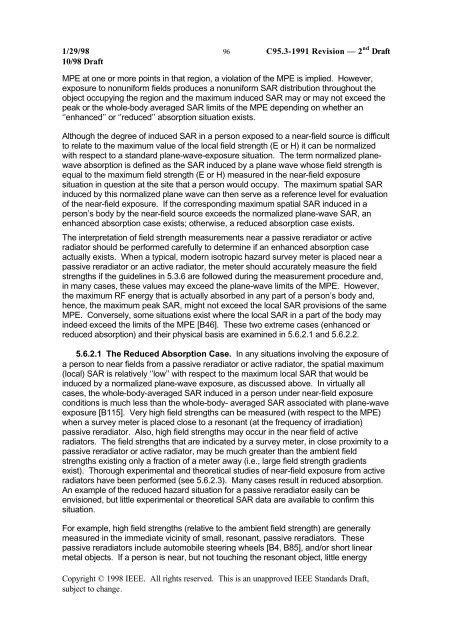DRAFT Recommended Practice for Measurements and ...
DRAFT Recommended Practice for Measurements and ...
DRAFT Recommended Practice for Measurements and ...
You also want an ePaper? Increase the reach of your titles
YUMPU automatically turns print PDFs into web optimized ePapers that Google loves.
1/29/98 96 C95.3-1991 Revision — 2 nd Draft<br />
10/98 Draft<br />
MPE at one or more points in that region, a violation of the MPE is implied. However,<br />
exposure to nonuni<strong>for</strong>m fields produces a nonuni<strong>for</strong>m SAR distribution throughout the<br />
object occupying the region <strong>and</strong> the maximum induced SAR may or may not exceed the<br />
peak or the whole-body averaged SAR limits of the MPE depending on whether an<br />
‘’enhanced’’ or ‘’reduced’’ absorption situation exists.<br />
Although the degree of induced SAR in a person exposed to a near-field source is difficult<br />
to relate to the maximum value of the local field strength (E or H) it can be normalized<br />
with respect to a st<strong>and</strong>ard plane-wave-exposure situation. The term normalized planewave<br />
absorption is defined as the SAR induced by a plane wave whose field strength is<br />
equal to the maximum field strength (E or H) measured in the near-field exposure<br />
situation in question at the site that a person would occupy. The maximum spatial SAR<br />
induced by this normalized plane wave can then serve as a reference level <strong>for</strong> evaluation<br />
of the near-field exposure. If the corresponding maximum spatial SAR induced in a<br />
person’s body by the near-field source exceeds the normalized plane-wave SAR, an<br />
enhanced absorption case exists; otherwise, a reduced absorption case exists.<br />
The interpretation of field strength measurements near a passive reradiator or active<br />
radiator should be per<strong>for</strong>med carefully to determine if an enhanced absorption case<br />
actually exists. When a typical, modern isotropic hazard survey meter is placed near a<br />
passive reradiator or an active radiator, the meter should accurately measure the field<br />
strengths if the guidelines in 5.3.6 are followed during the measurement procedure <strong>and</strong>,<br />
in many cases, these values may exceed the plane-wave limits of the MPE. However,<br />
the maximum RF energy that is actually absorbed in any part of a person’s body <strong>and</strong>,<br />
hence, the maximum peak SAR, might not exceed the local SAR provisions of the same<br />
MPE. Conversely, some situations exist where the local SAR in a part of the body may<br />
indeed exceed the limits of the MPE [B46]. These two extreme cases (enhanced or<br />
reduced absorption) <strong>and</strong> their physical basis are examined in 5.6.2.1 <strong>and</strong> 5.6.2.2.<br />
5.6.2.1 The Reduced Absorption Case. In any situations involving the exposure of<br />
a person to near fields from a passive reradiator or active radiator, the spatial maximum<br />
(local) SAR is relatively ‘’low’’ with respect to the maximum local SAR that would be<br />
induced by a normalized plane-wave exposure, as discussed above. In virtually all<br />
cases, the whole-body-averaged SAR induced in a person under near-field exposure<br />
conditions is much less than the whole-body- averaged SAR associated with plane-wave<br />
exposure [B115]. Very high field strengths can be measured (with respect to the MPE)<br />
when a survey meter is placed close to a resonant (at the frequency of irradiation)<br />
passive reradiator. Also, high field strengths may occur in the near field of active<br />
radiators. The field strengths that are indicated by a survey meter, in close proximity to a<br />
passive reradiator or active radiator, may be much greater than the ambient field<br />
strengths existing only a fraction of a meter away (i.e., large field strength gradients<br />
exist). Thorough experimental <strong>and</strong> theoretical studies of near-field exposure from active<br />
radiators have been per<strong>for</strong>med (see 5.6.2.3). Many cases result in reduced absorption.<br />
An example of the reduced hazard situation <strong>for</strong> a passive reradiator easily can be<br />
envisioned, but little experimental or theoretical SAR data are available to confirm this<br />
situation.<br />
For example, high field strengths (relative to the ambient field strength) are generally<br />
measured in the immediate vicinity of small, resonant, passive reradiators. These<br />
passive reradiators include automobile steering wheels [B4, B85], <strong>and</strong>/or short linear<br />
metal objects. If a person is near, but not touching the resonant object, little energy<br />
Copyright © 1998 IEEE. All rights reserved. This is an unapproved IEEE St<strong>and</strong>ards Draft,<br />
subject to change.
















